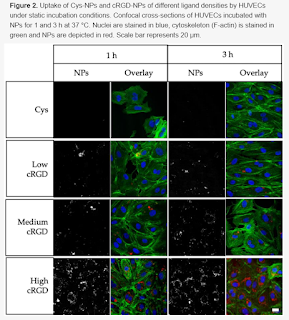Angiogenesis, the process by which blood vessels form and are grown, is a complicated biochemical process controlled by multiple signaling pathways. By providing a molecule which interacts with these pathways the growth of blood vessels can be controlled. This is an important pathway in terms of cancer treatment as cancers are often associated with inappropriate growth of blood vessels. Recently, researchers from Utrecht University, Royal Netherlands Academy of Arts and Sciences and University Medical Center Utrecht, University Medical Center Utrecht (Netherlands) utilized PLGA-PEG-Mal (AI020) from PolySciTech to develop RGD-targeted nanoparticles for endothelial targeting. This research holds promise to provide for better control of angiogenesis as a treatment option for cancer and other disease states. Read more: Martínez-Jothar, Lucía, Arjan D. Barendrecht, Anko M. de Graaff, Sabrina Oliveira, Cornelus F. van Nostrum, Raymond M. Schiffelers, Wim E. Hennink, and Marcel HAM Fens. "Endothelial Cell Targeting by cRGD-Functionalized Polymeric Nanoparticles under Static and Flow Conditions." Nanomaterials 10, no. 7 (2020): 1353. https://www.mdpi.com/2079-4991/10/7/1353
“Abstract: Since αvβ3 integrin is a key component of angiogenesis in health and disease, Arg-Gly-Asp (RGD) peptide-functionalized nanocarriers have been investigated as vehicles for targeted delivery of drugs to the αvβ3 integrin-overexpressing neovasculature of tumors. In this work, PEGylated nanoparticles (NPs) based on poly(lactic-co-glycolic acid) (PLGA) functionalized with cyclic-RGD (cRGD), were evaluated as nanocarriers for the targeting of angiogenic endothelium. For this purpose, NPs (~300 nm) functionalized with cRGD with different surface densities were prepared by maleimide-thiol chemistry and their interactions with human umbilical vein endothelial cells (HUVECs) were evaluated under different conditions using flow cytometry and microscopy. The cell association of cRGD-NPs under static conditions was time-, concentration- and cRGD density-dependent. The interactions between HUVECs and cRGD-NPs dispersed in cell culture medium under flow conditions were also time- and cRGD density-dependent. When washed red blood cells (RBCs) were added to the medium, a 3 to 8-fold increase in NPs association to HUVECs was observed. Moreover, experiments conducted under flow in the presence of RBC at physiologic hematocrit and shear rate, are a step forward in the prediction of in vivo cell–particle association. This approach has the potential to assist development and high-throughput screening of new endothelium-targeted nanocarriers. Keywords: nanoparticles; endothelial cells; RGD; targeting; physiological flow; PLGA”

No comments:
Post a Comment